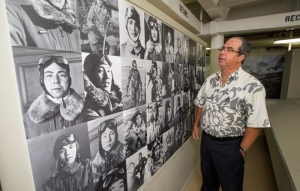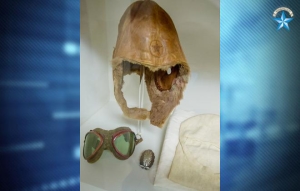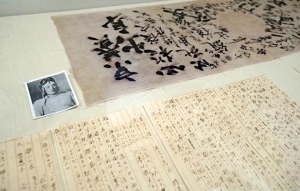Preservation in the News: Humanity mixes with tales of war and mayhem in new exhibit at the Battleship Missouri Memorial. Especially touching is the love letter from a kamikaze pilot to his fiance. See the full story below.
*********
USS Missouri hosts artifacts never seen before outside Japan
April 09, 2015 – Honolulu Star Advertiser
Humanity amid the savagery of war demonstrated 70 years ago in the Battle of Okinawa is being re-emphasized by the Battleship Missouri Memorial with a new exhibit on the kamikaze pilots whose suicide runs wreaked havoc on Allied ships late in World War II.
When a Japanese Zero crashed into the starboard side of the USS Missouri on April 11, 1945 — and the dead pilot’s body ended up on the ship — some of the crew wanted to toss the enemy’s remains overboard.

Michael Carr, president and CEO of the Battleship Missouri Memorial, looks at photos of kamikaze pilots in the exhibit. (Photo by Craig T Kojima)
But Missouri commander Capt. William M. Callaghan made the controversial decision to bury the aviator at sea the next morning with military honors including a makeshift Japanese flag draped over the body, a three-volley rifle salute and playing of taps.
On the 70th anniversary of the kamikaze attack on Saturday, the Missouri is opening a new exhibit that will “show today’s generations another side to the people engaged in war and how the world has changed since then” with artifacts never seen before outside of Japan.
On display are nine farewell letters sent home by the “tokko-tai” (special attack forces) with translations and photos of the pilots, uniform items, and a small “mascot doll” made by women in Japan and carried by many kamikaze pilots on their final missions in 1944-45, according to the Missouri, now a floating memorial and museum in Pearl Harbor.
“To dear Chieko,” wrote 23-year-old Toshio Anazawa to his fiancee before his suicide mission on April 12, 1945. “The two of us tried so hard by working together, but in the end we were unable to find a way to be united.”
Anazawa recalls saying goodbye in March and notes his fateful mission at hand.
“We’ve spent busy days moving from place to place,” he writes. “And now, the magnificent day of my attack sortie has arrived. I want to write to you. I have so much I want to say.”

Setsuo Ishino, top, was a 19-year-old kamikaze pilot who crashed his Zero, shown, into the USS Missouri on April 11, 1945. (Courtesy Battleship Missouri Memorial)
He says: “Now I don’t want to fruitlessly revisit the past with our relationship. The question is the future.”
Anazawa tells the woman he never wed that he wishes “for nothing other than your happiness.”
“Don’t waste your time with trifles from the past. You mustn’t live in the past,” he writes. “Take courage, forget the past, and find new ways to be happy in the future.”
“You have to live from now on in the reality of each moment. I, Anazawa, no longer exist in the world of reality.”
The Nakajima K1-43 land-based fighter pilot, promoted posthumously to the rank of captain, also indulges in some whimsy, saying it “seems silly to talk like this at such a time,” but he lists some books he’d like to read, and paintings he’d like to see, including Raphael’s “Madonna and Child.”
“From here on, please go forward cheerfully and brightly,” Anazawa concludes. “I, too, do my best not to trip over my feelings, but will head out to battle, smiling.”
The new exhibit “is a way to help us better tell the story of the kamikaze attack on the ship,” said Michael Carr, president and CEO of the Battleship Missouri Memorial. “It’s one of the ship’s most well-known stories and is a part of the tour we give to everybody.”

Masukotto ningyo, or “mascot dolls,” were made by women in Japan and carried by many kamikaze pilots during their final flights, becoming especially popular during 1944-45. (Courtesy Battleship Missouri Memorial.)
The starboard rail of the Missouri is still slightly dented where a Zero pilot, believed to be 19-year-old Setsuo Ishino, crashed in a glancing blow and was killed instantly. The starboard wing was thrown forward onto the deck and started a fire at a 5-inch gun mount, but the battleship suffered only superficial damage.
It’s not clear if a 500-pound bomb carried by the aircraft was jettisoned or still was with the plane, but it didn’t explode.
The Missouri went on to become more famously known as the site of Japan’s formal surrender to Allied forces on Sept. 2, 1945, in Tokyo Bay, ending the war.
Callaghan’s dignified burial of the kamikaze pilot “was an act of compassion on his part that resonates with anybody who knows that story,” Carr said.
On the flip side of that act, “what we hope by this exhibit to demonstrate is that they (kamikaze pilots) were people,” Carr added. “They were young men, probably scared out of their minds, but doing their duty.”
“We’re not making any judgments. We’re just telling a story,” Carr said.
The ship’s senior chaplain at the time of the kamikaze attack, Roland Faulk, said in a 1974 interview that “to some of the crew who grumbled because military honors were rendered, I reminded them that a dead enemy is no longer an enemy.”
As the Allied noose tightened on Japan, the Asian nation knew Okinawa would be decisive, and threw everything in, including their newest weapon, the kamikaze, Faulk said.
Callaghan is said to have spoken to the crew over the loudspeaker system about the traits of duty, honor and sacrifice exhibited by the Japanese pilot, Carr said.
“As far as I was aware, this was the only instance of its kind in World War II where such honors were renderered under such circumstances,” Faulk said in the past interview.

A helmet and goggles that were worn by kamikazi pilots is on display. (Photo: Craig T Kojima/Star Advertiser)
News of the burial was overshadowed by the death of President Franklin D. Roosevelt the same day.
After taking a Missouri tour and hearing about Callaghan’s consideration for the young Japanese pilot, Jessica Hutt, a visitor from Sydney, said, “I thought it was a nice thing that sort of outweighs the hideousness of war, I suppose.”
Carr said the new exhibit, which occupies a formerly unused portion of the ship’s mess, also is a way to attract more Japanese, only 2 percent to 3 percent of whom visit the “Mighty Mo” on a trip to Oahu.
The memorial said for 2014, it received 440,500 English-speaking visitors, 47,600 Japanese-speaking visitors, 28,300 Chinese speakers, and 900 others who speak Korean, Spanish or German.
Carr said “we do pretty well” with Chinese, with the Missouri getting about 20 percent of those who visit Oahu.
Dan Kawai, Japanese sales and marketing manager for the Missouri, said the ship’s kamikaze attack story is not well known in Japan.

Some of the artifacts to be displayed in the exhibit, including letters from the pilots and photographs. (Photo: Craig T Kojima/Star Advertiser)
The new exhibit not only dovetails with the compassionate burial of the Japanese pilot on April 12, 1945, but also resonates with Japanese visitors, Carr said.
“So as a way to hopefully attract more Japanese visitors and give them a reason to come and visit the Missouri, we thought we had to just tell them more of the story,” Carr said. “And in telling the story of the attack on the Missouri and the research that we went into to try and discover who that pilot was, you inevitably just learn more about the back story, and who the kamikaze pilots were in general.”
The kamikaze artifacts, never seen before outside of Japan, are on loan from the Chiran Peace Museum, which was built in the same location where many of the kamikaze pilots departed for their final mission. They will be on display through Nov. 11, Veterans Day.
_____
FAREWELL, WITH LOVE
This is the last letter written by Toshio Anazawa, age 23, to his fiancee, Chieko. Promoted to the rank of captain posthumously, he piloted a Nakajima K1-43 fighter to his death on April 12, 1945.
To dear Chieko,
The two of us tried so hard by working together, but in the end we were unable to find a way to be united.
Even while we were holding out hope, the fear lurking in our hearts that we might “miss the chance” has now become a reality.
Cherishing in our heart the happy days of the future, we said goodbye at Ikebukuro station on 10th of last month, but as soon as I returned to base, the situation for our squadron took a major turn. All correspondence was forbidden for the duration. (Now of course that ban has been
lifted.) We’ve spent busy days moving from place to place. And now, the magnificent day of my attack sortie has arrived. I want to write you. I have so much I want to say.
And yet, I know that all of them amount to nothing other than words of gratitude for the depth of the love you have shown me.
Your parents, elder brother, elder sister, younger sister, younger brother: All of them were wonderful people.
No conventional words of thanks can convey my gratitude for the many kindnesses they bestowed upon me, but still I will say with the purest of intentions from the bottom of my heart, “Thank you ever so much.”
Now I don’t want to fruitlessly revisit the past with our relationship. The question is the future. I believe that your innate intelligence will guide you at all times in judging the proper path. And yet, apart from this, speaking to the woman in you, I want to convey a few things as a man to whom you were engaged, and as a man who will fall in battle.
“I wish for nothing other than your happiness.”
“Don’t waste your time with trifles from the past. You mustn’t live in the past.”
“Take courage, forget the past, and find new ways to be happy in the future.”
“You have to live from now on in the reality of each moment. I, Anazawa, no longer exist in the world of reality.”
This line of thought might seem extremely abstract, but when I ask you to live on, making the most of each situation one by one, I think you’ll understand that it isn’t out of a sense of selfishness. I’m speaking from a position of pure objectivity. Here the cherry blossoms have already fallen. The young green leaves you love so much will soon come to usher in a new season of spring.
It seems silly to talk like this at such a time, but I feel like being a bit greedy for a moment.
- Books I’d Like to Read
Man’yoshu
Kushu
Doutei
Ittensho
Furusato - Paintings I’d Like to See
Raphael’s Madonna and Child
Hogai’s Merciful Mother Kannon - Chieko, I want to meet you, to talk with you, with all my heart.
From here on, please go forward cheerfully and brightly. I too do my best not to trip over my feelings, but will head out to battle, smiling.
From Toshio

